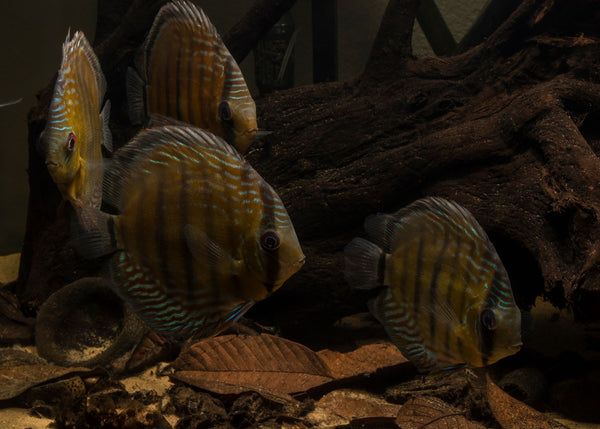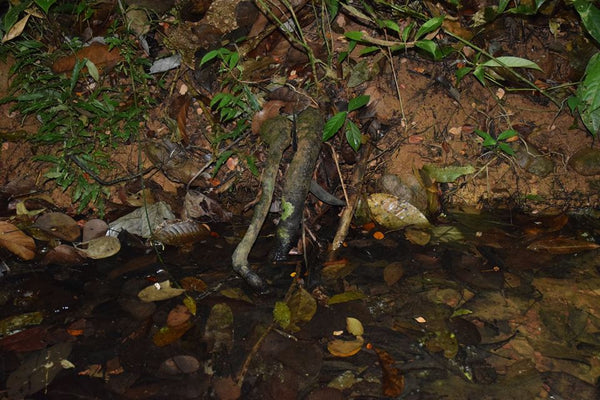- Continue Shopping
- Your Cart is Empty
The land of the Tucanos: A case study of a good, but not perfect philosophy
One of the best things about writing your own blog every day is that you develop- well, for want of a better word- fans. And fans not only consume your content; they analyze it, discuss it, criticize it, and request more of it!

One of the many questions I received lately was about how my philosophy of creating a tank works. Now, at first, I had to laugh a bit...I was like, "Umm, you buy a tank, fill it with water, and..." Of course, that WASN'T the gist of the question. What the questioner really wanted to know was how I decide what to include and how to configure my aquariums; what guides these decisions.
It's a pretty good question!
The summarized answer? It's all about the habitat.
Now, I don't profess to be some sort of "guru" on the philosophy of aquarium design and such. However, I do have some definite opinions about what drives my designs.

First off, I am a keen observer and student of wild aquatic habitats and ecological niches in the tropical world. I have found that I am drawn to certain types of habitats; typically, those in which terrestrial materials, like soil, leaves, seed pods, and the like influence the ecological characteristics of the water, and the fishes which live there.
That being said, I will not only observe the aesthetics of the habitat which I want to replicate- I spend a ridiculous amount of time trying to replicate, as faithfully as possible, the function of the habitat as well. The whole tagline for Tannin, "Leaves. Wood. Water. Life" sums up beautifully my mindset: That the aquatic environment strongly influences the health and sustainability of the fishes I keep, and that it's as important to curate and utilize natural materials in such a way as to mimic the habitat as it is to select great specimens.

I have long believed that, despite the fact that many fishes, like Discus, Tetras, etc. are kept and bred successfully in hard, alkaline "tap water" conditions- and have been for generations in the hobby/industry- there is almost always something to be gained by "repatriating" our fishes to conditions that are similar to those which they have evolved to live in for eons.

I just don't believe that a few dozen generations of captive breeding under dramatically different environmental conditions (ie; hard and alkaline water) than their wild environments have eclipsed or erased the evolutionary adaptations to specific conditions. I mean, sure, just because fishes are adaptable to radically different environmental parameters than they evolved to thrive under doesn't meant that it's "better" for them.
I think we can and should do things a bit differently.
We have to draw a distinction between what's best for the fishes and what's easiest for us as hobbyists to create and maintain. And arguably, if we don't bother to study, understand, and appreciate the wild aquatic habitats from which our fishes hail, how can we understand their fragility and the dramatic impacts of humans on them? Your fishes may "come from a hatchery"... But that's not where fishes come from. Make sense?
I think so.

So, to summarize- my philosophy is to study and understand the environments from which our fishes come, and to replicate them in function and form as best as possible. It doesn't always mean exactly- but it's definitely NOT forcing them to adapt to our "local tap water "conditions without any attempt to modify them.
I have a very current "case study" of my own that sort of reflects the execution of my philosophy.
As many of you know, I've had a long obsession with the idea of root tangles and submerged accumulations of leaves, branches, and seed pods. I love the silty, sedimented substrates and the intricate interplay of terrestrial plant roots with the aquatic environment.

I was doing a geeky "deep dive" into this type of habitat in Amazonia, and stumbled upon this gem from a scientific paper by J. Gery and U. Romer in 1997:
"The brook, 80-200cm wide, 50-100 cm deep near the end of the dry season (the level was still dropping at the rate of 20cm a day), runs rather swiftly in a dense forest, with Ficus trees and Leopoldina palms...in the water as dominant plants. Dead wood. mostly prickly trunks of palms, are lying in the water, usually covered with Ficus leaves, which also cover the bottom with a layer 50-100cm thick. No submerse plants. Only the branches and roots of emerge plants provide shelter for aquatic organisms.
The following data were gathered by the Junior author Feb 21, 1994 at 11:00AM: Clear with blackwater influence, extremely acid. Current 0.5-1 mv/sec. Temp.: Air 29C, water 24C at more than 50cm depth... The fish fauna seems quite poor in species. Only 6 species were collected I the brook, including Tucanoichthys tucano: Two cichlids, Nannacara adoketa, and Crenicichla sp., one catfish, a doradid Amblydoras sp.; and an as yet unidentified Rivulus, abundant; the only other characoid, probably syncopic, was Poecilocharax weitzmani."
Yeah, it turned out to be the ichthyological description of the little "Tucano Tetra", and was a treasure trove of data on both the fish and its habitat. I was taken by the decidedly "aquarium reproducible" characteristics of the habitat, both in terms of its physical size and its structure.
Boom! I was hooked.

I needed to replicate this habitat! And how could I not love this little fish? I even had a little aquarium that I had been dying to work with for a while.
It must have been "ordained" by the universe, right?
Now, I admit, I wasn't interested in, or able to safely lower the pH down to 4.3 ( which was one of the readings taken at the locale), and hold it there, but I could get the "low sixes" nailed easily! Sure, one could logically call me a sort of hypocrite, because I'm immediately conceding that I won't do 4.3, and I suppose that could be warranted...
However, there is a far cry between creating 6.2pH for my tank, which is easy to obtain and maintain for me, and "force-fitting" fishes to adapt to our 8.4pH Los Angeles tap water!

So, even the "create the proper conditions for the fish instead of forcing them to adapt to what's easiest for us" philosophy can be nuanced! And it should! I don't want to mess with strong acids at this time. It's doable...a number of hobbyists have successfully. However, for the purposes of my experiment, I decided to abstain for now, lol.
And without flogging a dead horse, as the horrible expression goes, I think I nailed many of the physical attributes of the habitat of this fish. By utilizing natural materials, such as roots, which are representative of those found in the fish's habitat, as well as the use of Ficus and other small leaves as the "litter" in the tank, I think I'm well on the way to creating a cool biotope-inspired display for these little guys!

That's one example of this philosophy in action. Again, it's NOT perfect. It's certainly something that can- and should- be improved upon. The pH thing, for example. But the physical environment; the biological nuances...the long-term function of this type of aquarium microcosm...I think we are well on our way to building a lot of "best practice" stuff here.
I'm still not satisfied yet...
However, I think it's a good start.
I think it also requires the usual caveats- a "mindset shift" that embraces the fact that the natural habitats we love don't always meet our "acculturated" aesthetic expectations. We need to understand that Nature does her own thing, regardless of whether we "approve" of it or not!
Keep striving.
Stay bold. Stay studious. Stay curious. Stay diligent. Stay open-minded. Stay methodical...
And Stay Wet.
Scott Fellman
Tannin Aquatics






Scott Fellman
Author